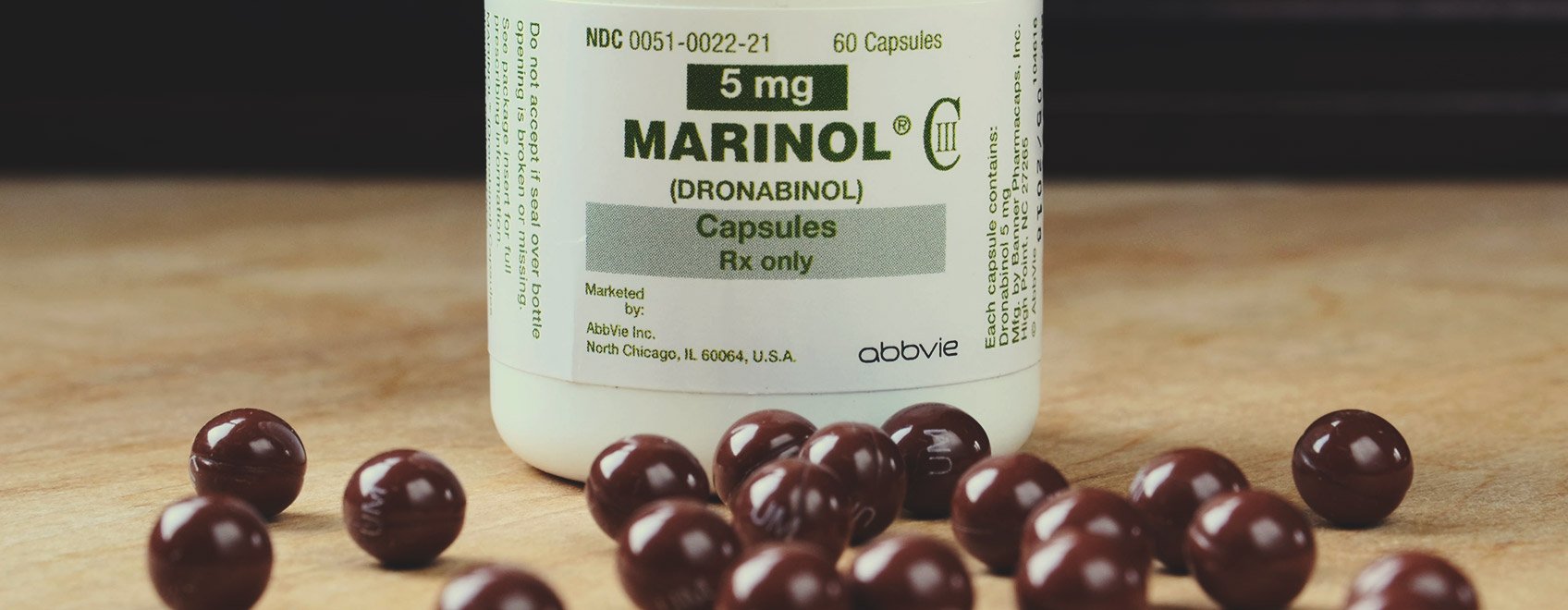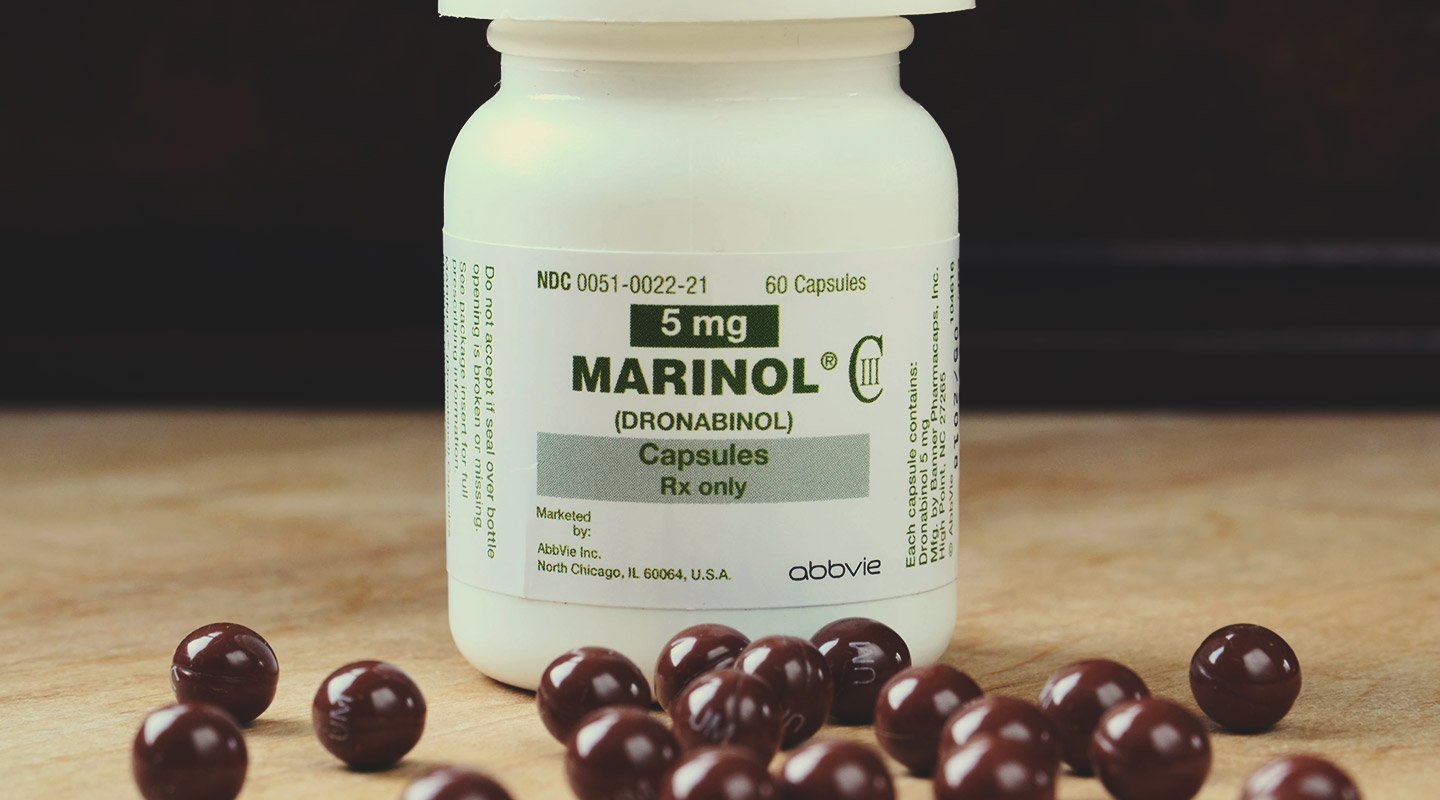.

What Is Marinol, and How Does It Differ From Cannabis?
Although cannabis remains illegal in much of the world, pharmaceutical companies can cash in on synthetic cannabinoids. Medications like Marinol are approved to treat certain conditions and help to improve patient quality of life. But why is it legal? Is Marinol safer than THC or medical marijuana? Find out how this synthetic medicine compares.
Cannabis users all over the world risk prosecution when they grow the herb. But several pharmaceutical companies are making big bucks from cannabis-based medicines in countries where cultivation remains illegal. This fact angers a lot of people, and rightly so. Still, prescription drugs such as Marinol are making a difference in the lives of some patients. But are synthetic cannabinoids superior to using the whole cannabis plant?
Find out everything you need to know about Marinol below, including how it compares to THC and medical marijuana as a whole.
Contents:
What Is Marinol?
Marinol is a branded version of dronabinol, a synthetic version of THC. Several countries have legalized the prescription of dronabinol, under different brand names, including the United States, Germany, South Africa, and Australia. In the case of Marinol, the product takes the form of capsules containing 2.5mg, 5mg, or 10mg of THC suspended in sesame seed oil.
Marinol Uses: What Is Marinol Prescribed For?
The Food and Drug Administration (FDA) in the United States has approved Marinol for the treatment of two conditions.
Wasting Syndrome Associated With HIV/AIDS
Patients with HIV/AIDS are diagnosed with wasting syndrome when they involuntarily lose at least 10% of their body weight. Symptoms such as diarrhoea, weakness, and fever often accompany this rapid weight loss. The condition arises for several reasons, including:
| Patients avoiding antiretroviral therapy (ART) medications | A sudden loss in appetite | Metabolic changes caused by increased immune system activity or altered hormones | Reduced ability to absorb nutrients as HIV damages the intestinal lining | The body manufacturers fewer amounts of proteins required to build muscle |
| Patients avoiding antiretroviral therapy (ART) medications | A sudden loss in appetite |
| Metabolic changes caused by increased immune system activity or altered hormones | Reduced ability to absorb nutrients as HIV damages the intestinal lining |
| The body manufacturers fewer amounts of proteins required to build muscle |
If you use cannabis, you’ll know how effectively THC can impact appetite. Marinol achieves a similar effect. By increasing appetite in HIV and AIDS patients, the synthetic cannabinoid helps them to take in more calories, maintain and build muscle mass, and prevent further rapid weight loss.
An FDA document[1] cites a study that showed Marinol pills to significantly increase and sustain appetite in patients experiencing AIDS-related wasting. The subjects received an initial daily dose of 5mg, divided into two doses of 2.5mg—one taken before lunch, and one before dinner.
Current dosage guidelines follow the successful pattern utilised in this research. Patients are advised to take their prescribed dose one hour before lunch to boost their appetite, and again one hour before their final meal of the day.


Chemotherapy-Induced Nausea and Vomiting
Chemotherapy takes a heavy toll on the body. Although it works to treat cancer in some patients, it can leave them feeling fatigued and sick to their stomachs. In fact, up to 80% of cancer patients that undergo chemo experience nausea and vomiting as a side effect.
A combination of nausea and vomiting, reduced appetite, and diarrhoea can cause cancer patients to lose a lot of weight over a short period of time. Doctors in the United States can prescribe Marinol to battle these symptoms and improve their appetite. The FDA recommends a starting dose, based on the body area of each patient, of 5mg/m². Patients take their first dose 1–3 hours before receiving chemotherapy, followed by doses every 2–4 hours after treatment, for a total of 4–6 doses each day.
While the FDA has only approved Marinol for these two conditions so far, clinical trials have investigated the role of the drug in other maladies, including:
| Chronic pain | Fibromyalgia | Multiple sclerosis | Amyotrophic lateral sclerosis (ALS) | Sleep apnea | Dementia |
| Chronic pain | Fibromyalgia |
| Multiple sclerosis | Amyotrophic lateral sclerosis (ALS) |
| Sleep apnea | Dementia |
Will Marinol Get You High?
Yes. Marinol shares an exceptionally similar molecular structure to THC, and therefore produces similar effects in the body. When compared side by side, the two chemicals look almost identical. Marinol simply possesses more of certain elements, and some elements sit at slightly different positions on the molecule.
When you smoke weed, THC passes through your blood–brain barrier and binds with CB1 receptors of the endocannabinoid system. This causes a shift in neurotransmitter firing that underpins the high. Marinol works through the same mechanism, but many users report much stronger effects. The patient handout warns users of possible psychological side effects[2], including:
These potent effects likely stem from the fact that patients take Marinol capsules orally. Edible cannabis has a notorious status for catching people off guard and forcing them to endure rather uncomfortable experiences, to put it lightly. After chomping down a weed-infused brownie, THC eventually passes through the liver, which converts it into the more potent and longer-lasting 11-hydroxy-THC.
Even though only 10–20% of ingested Marinol makes it into systemic circulation, this cannabinoid also makes the switch to 11-hydroxy-THC, which plunges many patients into an unpleasant psychological state.
Marinol vs THC
Despite their chemical similarity, Marinol and THC feature a long list of differences, from their legal status and cost to therapeutic uses.
Application
Marinol users are limited to swallowing capsules. This sends the cannabinoid through the digestive tract, metabolises it into 11-hydroxy-THC, and produces an effect that hits harder and lasts longer.
In comparison, THC users have a much more diverse set of options. Although some users prefer isolated THC products similar to Marinol, others prefer the molecule in its more natural state—bound up in trichomes. The wide range of THC products available includes:
| Cannabis flowers | There are thousands of strains available, and each offers varying levels of THC to meet the demands of users. |
| Edibles | Dispensaries and coffeeshops sell a wide variety of edibles, including gummies, cakes, brownies, capsules, and tinctures. |
| Full-spectrum extracts & concentrates |
These products offer higher levels of THC than raw flowers, but still contain other phytochemicals such as terpenes and flavonoids. |
| THCA crystals |
These isolated products, which convert to THC when heated, offer THCA concentrations of up to 99.9%. |
| Cannabis flowers |
|
There are thousands of strains available, and each offers varying levels of THC to meet the demands of users. |
| Edibles |
|
Dispensaries and coffeeshops sell a wide variety of edibles, including gummies, cakes, brownies, capsules, and tinctures. |
| Full-spectrum extracts & concentrates |
|
These products offer higher levels of THC than raw flowers, but still contain other phytochemicals such as terpenes and flavonoids. |
| THCA crystals |
|
These isolated products, which convert to THC when heated, offer THCA concentrations of up to 99.9%. |
Legality
The legality surrounding Marinol and THC might send your head spinning. It all makes very little sense. The FDA first approved the Marinol drug in 1985, yet it remained classified as a Schedule I drug—a substance defined as having no currently accepted medical use, and a high potential for abuse.
One year later, the Drug Enforcement Agency (DEA) decided to reclassify Marinol as a Schedule II substance. Drugs in this category are recognized to have some medical utility, but still pose a high potential for abuse. Finally, in 1999, the agency reclassified Marinol as a Schedule III drug, meaning it poses a moderate to low risk of physical dependence.
Here’s where things get a little confusing. Patients can now legally access some form of cannabis in 37 states in the US, but the federal government and DEA still regard cannabis as a Schedule I drug. In their eyes, the plant has no recognized medical application, and a high potential for abuse. However, the DEA allows access to Marinol—a compound almost identical to THC—in all 50 states.
Granted, Marinol might pose less abuse potential on the grounds that users find the high unpleasant. However, the synthetic cannabinoid can also cause severe adverse psychological effects and allergic reactions that are far less frequent with natural cannabis.
Therapeutic Use
As a single molecule with one current route of administration, Marinol has limited pharmacological action. However, it does seem to improve the symptoms of a few serious conditions.
So, how does THC compare? Well, users rarely use the cannabinoid in isolation. Instead, it arrives in a botanical package alongside hundreds of other phytochemicals. Ongoing studies are investigating the potential of medical marijuana in a whole host of conditions, including but not limited to:
| Epilepsy | Glaucoma | Nausea | Pain | Cancer | Alzheimer’s disease |
| Epilepsy | Glaucoma |
| Nausea | Pain |
| Cancer | Alzheimer’s disease |
High-THC cannabis also harnesses a versatility that Marinol cannot. Whereas Marinol falls into the reductionist “one-molecule, one-receptor” paradigm, cannabis takes advantage of diversity. Every hit of cannabis delivers many different cannabinoids, terpenes, and other molecules into the body. Early research suggests these molecules might synergise to create more pronounced effects[3], working in a way that science doesn’t yet entirely understand.
Cost
Marinol costs considerably more than cannabis[4]. One bottle of 60 capsules, containing 2.5mg each, costs $734. This amount provides a total of 150mg of Marinol. Although expensive, some health insurance packages will cover these costs in the United States.
In comparison, medical cannabis customers can purchase around 2.1 oz of flower, at California prices, with this amount of cash. This equates to anywhere between 5,000–8,000mg of THC, depending on the strain.
Is Marinol Dangerous?
Most patients tolerate Marinol well and don’t experience serious side effects. However, much like THC, the synthetic cannabinoid can cause adverse psychological effects[5], especially in people with a history of mental illness.
But Marinol can produce more extreme side effects, including seizures. Some patients are also at risk of a severe allergic reaction[6], which can manifest as severe dizziness, rash, itching, and trouble breathing.
- MARINOL® https://www.accessdata.fda.gov
- Marinol, Syndros (dronabinol) dosing, indications, interactions, adverse effects, and more https://reference.medscape.com
- Taming THC: potential cannabis synergy and phytocannabinoid-terpenoid entourage effects https://ethanrusso.org
- Marinol Prices, Coupons & Patient Assistance Programs - Drugs.com https://www.drugs.com
- Marinol: Drug Uses, Dosage & Side Effects - Drugs.com https://www.drugs.com
- Marinol Oral: Uses, Side Effects, Interactions, Pictures, Warnings & Dosing - WebMD https://www.webmd.com







































